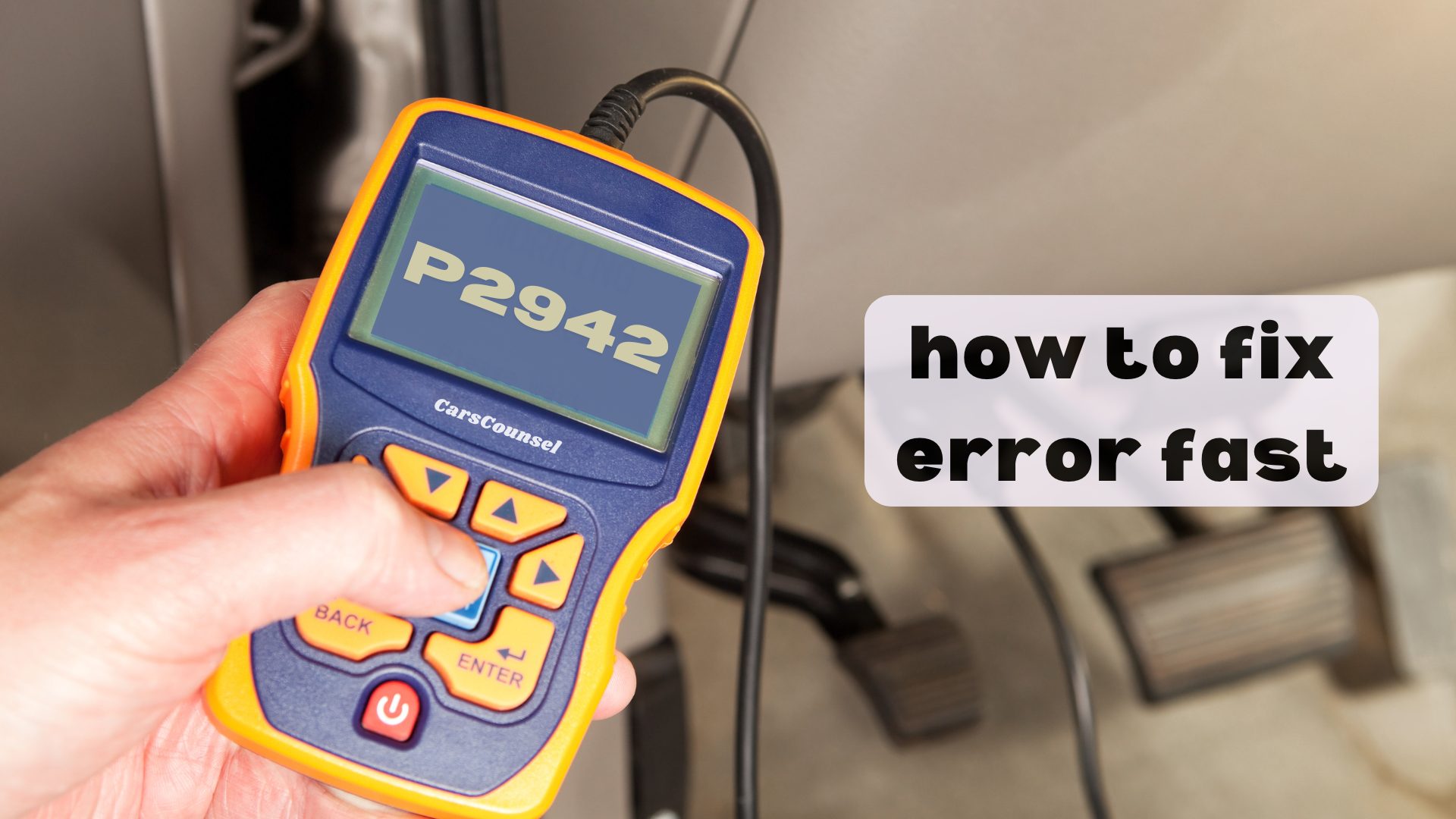Dealing with the P2942 code can be challenging, but you can handle it effectively by following a clear set of steps.
First, use an OBD-II scanner to confirm the error code and check for any additional codes. It’s crucial to check your transmission fluid levels and make sure the fluid is clean. If the fluid is dirty or low, you may need to flush and replace it.
Next, examine the transmission fluid pressure sensor and its wiring for any damage or disconnections.
Finally, clear the codes and take your car for a test drive to ensure the problem is fixed.

Quick Navigation
Key Takeaways
- Replace the bad transmission fluid pressure sensor: Disconnect the battery, take out the old sensor, put in the new one, and reconnect the battery.
- Check and maintain transmission fluid levels: Make sure the fluid is clean and at the right level. If needed, flush and replace it.
- Look over and fix wiring and connectors: Check for damage, rust, or discoloration. Clean and secure the connections, replacing any bad parts.
- Do a pressure test: Use a pressure gauge to check the readings against what the manufacturer says they should be. Look for any irregularities.
What Is P2942 Code?
The P2942 code is an error code that tells you there’s a problem with the Transmission Fluid Pressure Sensor/Switch E Circuit, which is important for keeping your transmission working properly.
When this code shows up, it means there’s an issue with the sensor that checks and controls the fluid pressure in the transmission. This sensor is crucial for smooth gear shifts and efficient transmission performance.
If it stops working right, it can lead to wrong pressure readings, causing problems with gear shifting and possibly damaging the transmission.
Figuring out and understanding this code is the first step in diagnosing and fixing the problem to keep your vehicle’s transmission in good shape.
Importance of Addressing P2942
Ignoring the P2942 code can seriously damage your transmission and lead to expensive repairs. It’s crucial to fix this code quickly to keep your transmission in good shape.
The transmission fluid pressure sensor/switch is key for maintaining the right pressure in the system. If it fails, you might experience rough gear shifts, slipping, and overheating, which can cause major transmission problems.
Regularly checking and maintaining your transmission fluid is important. Keeping the fluid clean and at the right level helps prevent issues that can trigger the P2942 code.
Common Causes of P2942
Low transmission fluid levels often cause the P2942 code, disrupting the hydraulic function essential for proper transmission operation. This issue can stem from neglecting transmission maintenance.
Another common cause is a faulty pressure sensor or switch, which affects accurate pressure readings necessary for efficient transmission performance. Damaged wiring or connectors can also lead to incorrect sensor signals, making sensor troubleshooting more complicated.
Here are three common causes:
- Low Transmission Fluid: Low fluid levels can mess up the hydraulic system.
- Faulty Pressure Sensor/Switch: A bad sensor can give wrong pressure readings.
- Wiring/Connector Issues: Broken wiring can mess up sensor signals.
Fixing these problems quickly ensures your vehicle’s transmission system works properly and prevents more issues down the road.
Symptoms of P2942 Code
When the P2942 code pops up, your car’s dashboard lights will turn on, warning you about a problem with the transmission. You might notice the transmission slipping or shifting hard, making it tough to drive.
The engine could also act up, making the driving experience even worse. Gas mileage will likely drop, showing that the system isn’t running efficiently. If you ignore fluid maintenance, these problems can get worse, possibly leading to the transmission overheating.
It’s important to address these issues quickly to avoid major damage. Keep an eye on your dashboard and pay attention to any changes in how your car drives to catch these problems early and keep your transmission in good shape.
Diagnosing P2942 Error
To fix the P2942 error, start by using an OBD-II scanner to get the diagnostic codes and understand what’s going wrong. This first step is crucial for proper transmission maintenance and sensor calibration.
Then, follow these steps:
- Pressure Test: Check the transmission system pressure to spot any irregularities or issues.
- Visual Inspection: Look at the wiring and connectors for any damage, rust, or wear that could affect how the sensor works.
- Transmission Fluid Check: Make sure the transmission fluid isn’t dirty and is at the right level, as both can mess with sensor readings.
Using a Diagnostic Scanner
To diagnose the P2942 code, start by connecting an OBD-II scanner to your car’s diagnostic port to get specific error codes and system data.
These scanners are crucial for finding the exact problem. Once connected, the scanner will show the P2942 code and any related codes that might give you more information.
Pay close attention to sensor calibration data because wrong calibrations can cause incorrect readings.
Look at the live data stream to check for any odd readings in the transmission fluid pressure sensor. This will help you figure out if the sensor is broken or if there’s a different issue.
Accurate diagnostics are key to making the right repairs and keeping your car in good shape.
Conducting a Pressure Test
Start the pressure test by hooking up a pressure gauge to the transmission system to get an accurate reading of the fluid pressure. This is crucial for figuring out the P2942 code. Make sure the engine is warmed up and the transmission fluid levels are correct.
Follow these steps:
- Connect the Pressure Gauge: Attach the pressure gauge to the test port on the transmission.
- Check Readings: Start the engine and watch the pressure readings as you shift through different gears.
- Compare Values: Compare the pressure readings to what the manufacturer says they should be.
If the pressure readings aren’t within the normal range, it might mean there are issues with fluid levels, a bad pressure sensor, or other mechanical problems.
Getting accurate measurements is key for good troubleshooting and repair.
Inspecting Wiring and Connectors
Inspecting wiring and connectors means looking for any visible damage, rust, or loose connections that could mess with the transmission fluid pressure sensor’s signal.
Start by checking the harness for signs of fraying, cuts, or wear.
Look closely at the connectors for rust or discoloration, which can mean water got in or there’s been electrical arcing.
Make sure all connections are tight and properly fitted.
Keeping connectors clean is crucial; if they’re dirty, clean them with the right electrical cleaner and use dielectric grease to stop future rust.
If you see any damaged wiring or bad connectors, fix or replace them right away.
Well-maintained wiring and connectors ensure the sensor reads accurately and the transmission works reliably.
Analyzing Transmission Fluid
After making sure the wiring and connectors are in good shape, check the transmission fluid to spot any problems that might be messing with your system. Keeping your transmission well-maintained is crucial to avoid P2942 code errors. Here’s what to examine:
- Fluid Levels: Make sure the transmission fluid is at the right level. Low fluid can cause performance problems.
- Fluid Condition: Look for dirty or burnt fluid. Contaminated fluid can hurt the transmission’s performance.
- Fluid Color and Odor: Good fluid is usually red and has a mild smell. If the fluid is dark, discolored, or smells bad, it could mean there’s contamination or internal damage.
Fixing P2942 Code
To fix the P2942 code, start by replacing the faulty transmission fluid pressure sensor or switch to get accurate pressure readings again. This sensor replacement is crucial for keeping your transmission in good shape.
First, find the sensor, which is usually located on or near the transmission. Disconnect the battery to stay safe, then remove the faulty sensor. Install the new sensor, ensuring it’s securely connected.
Reconnect the battery and check for any error codes using an OBD-II scanner. Also, look for and fix any damaged wiring or connectors.
If the transmission fluid is dirty or low, flush it out and replace it. These steps will help keep your transmission running smoothly and prevent more problems.
More OBD-II Codes
Frequently Asked Questions
Can Driving With a P2942 Code Damage My Transmission?
Yes, driving with a P2942 code can really damage your transmission. If you keep driving and ignore gear shifting problems, it can make things worse, leading to costly repairs or even total transmission failure if you don’t fix it soon.
How Much Does It Typically Cost to Fix a P2942 Error?
Fixing a P2942 error usually costs between $150 and $500, including the fee for diagnosing the problem. It’s worth spending the money now because ignoring it could lead to much more expensive transmission damage later.
Are There Any Temporary Fixes for the P2942 Code?
For temporary fixes, you can try adding more transmission fluid if it’s low, cleaning the connectors, or resetting the car’s computer. However, these are just short-term solutions. You’ll need a professional to diagnose the issue for a long-lasting repair.
How Long Does It Take to Diagnose and Repair a P2942 Code?
Figuring out and fixing the P2942 code can be tricky. With the right tools, a professional can usually find the problem and fix it in about 1-2 hours.
Can a P2942 Code Affect Other Vehicle Systems?
Yes, a P2942 code can impact other parts of your vehicle. Problems like engine running poorly and the transmission getting too hot can be caused by issues such as bad sensors or low fluid levels, affecting how well your vehicle works overall.
Conclusion
Imagine your car running smoothly without any error codes or transmission problems.
By quickly fixing the P2942 code, you’ve ensured top performance and a longer life for your car.
You’ve checked the fluid, inspected the wiring, and tested the pressure—each step getting you closer to fixing the issue.
Now, with the error gone and a successful test drive under your belt, you’re ready to drive with confidence.
Stay alert and keep your car in great shape.

